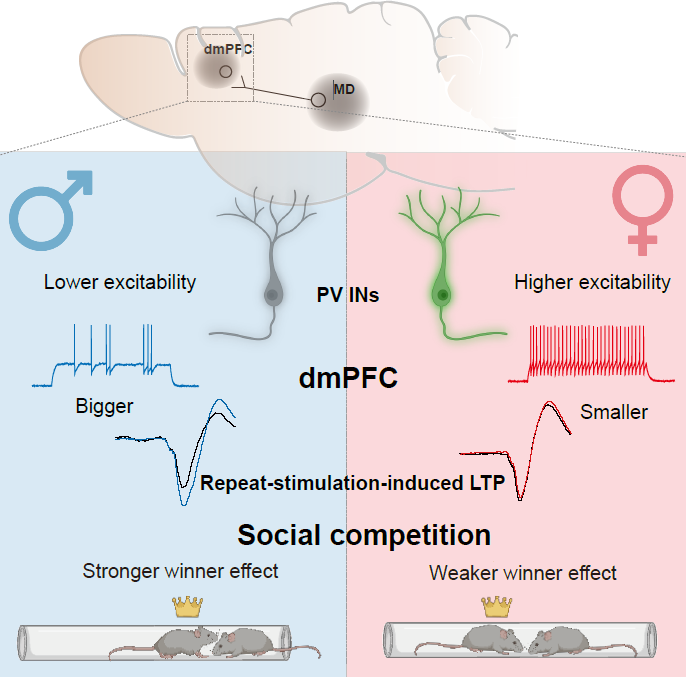The research team led by Prof. Hailan Hu has recently published an article titled Neural mechanism of the sexually dimorphic winner effect in mice on Neuron online on Oct. 15, 2025. This research revealeddmPFC PV-INs as a target for enhancing the winner effect, establishing a circuit-level framework for sex differences in competitive behaviors.
The ‘‘winner effect,’’ where prior victories increase the likelihood of future wins, profoundly shapes social hierarchy dynamics and competitive motivation. Although human literature suggests a less pronounced winner effect in females, the neural mechanisms underlying these sex differences remain unclear. Here, we show that, compared with male mice, female mice take longer to form social hierarchies and exhibit a weaker winner effect. The dorsomedial prefrontal cortex (dmPFC), crucial for social dominance in males, plays a similar role in female mice. However, female mice exhibit reduced long-term potentiation (LTP) at the mediodorsal thalamus (MDT)-to-dmPFC synapses. In vitro recordings revealed that female mice have heightened excitability of dmPFC parvalbumin interneurons (PV-INs). Modulation experiments revealed that PV-IN activity controls LTP at MDT-to-dmPFC synapses and dominance behavior in a sex-dependent manner: increasing PV-IN excitability in male mice suppressed LTP and weakened the winner effect, whereas reducing PV-IN excitability in female mice enhanced LTP and promoted the winner effect. These findings point to a model in which elevated GABAergic inhibition from dmPFC local PV-INs raises the threshold for LTP induction in females, dampening the winner effect. This work identifies dmPFC PV-INs as a target for enhancing the winner effect, establishing a circuit-level framework for sex differences in competitive behaviors.

Sexually dimorphic winner effect driven by dmPFC PV interneuron excitability
https://www.cell.com/neuron/fulltext/S0896-6273(25)00717-2
HAILAN HU'S RESEARCH GROUP: For social animals, emotions and health are regulated by various social behaviors. Hailan Hu's group is dedicated to studying the neural basis and plasticity mechanisms of emotion and social behavior. They use cutting-edge techniques including imaging, electrophysiology (both in vitro and in vivo), molecular genetics, and optogenetics to conduct deep analysis of emotion- and social behaviors- and their related neural circuits.




 Location :
Location : 

